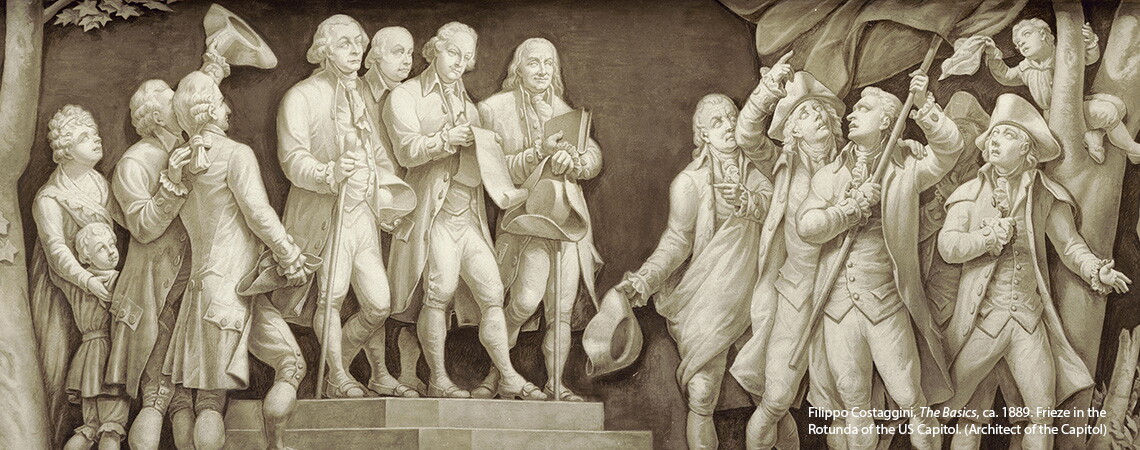From the Editor
by Carol Berkin
The Declaration of Independence produced a crisis of loyalties for the American people. For many, it was a just and fair call for release from the control of a British king and Parliament that had turned a mother country into an oppressor. For others, it was a renunciation of one’s oath to obey established authority and a rejection of the strong historical and cultural links that bound colonists to the land of their origins. Although some thousands called it an act of treason, the majority of men and women supported the principles of self-determination and the promise of liberty enshrined in Jefferson’s Declaration. In this issue of History Now, we focus on the reactions of Americans who faced this crisis of loyalties.
In his essay, “The Proclamation, Reading, and Immediate Reception of the Declaration of Independence,” Professor John R. Vile traces the political events and economic policies that led to the official break with England. On July 4, 1776, Jefferson’s Declaration was made available to the colonists and the world. It was first read aloud in Philadelphia, in Easton, Pennsylvania, and in Trenton, New Jersey, but it could soon be heard up and down the colonies, in public squares and church pulpits, often accompanied by cheering, the firing of cannons, and the ringing of bells. While some celebrated it with parades and the destruction of royal symbols, not everyone was certain that the Declaration’s rousing assertion of liberty and equality applied to them. African Americans and women hoped that it did. Across the ocean, the French government showed support for American independence, more out of rivalry with England than any commitment to the American cause.
In her essay, “The Revolutionary Era West, before and after American Independence,” Professor Jessica Choppin Roney reminds the reader of the critical role the West played in moving the colonists to their crisis of loyalties. Before the Boston Tea Party, Parliament had laid plans to stabilize and regulate western settlement by creating a new colony made up of much of present-day West Virginia, Kentucky, and western Pennsylvania. But colonial protests and the Boston Tea Party caused this effort to be abandoned. As independence drew near, the question of the western lands became divisive. Native Americans opposed westward settlement by colonists while White men eager to acquire western lands grew resentful of the lack of support provided to them by the coastal-based colonial governments. After independence, the debate over control of the West continued, this time as a struggle among the states themselves, and this delayed the ratification of the Articles of Confederation.
In his essay, “Lemuel Haynes, Young African American Patriot of the 1770s,” Professor John Saillant introduces us to a Massachusetts free mulatto man who argued against tyranny and advocated for equality even before the Declaration was signed. Self-educated, Haynes authored two important manuscripts, a poem entitled “The Battle of Lexington” and an essay, “Liberty Further Extended,” that took the form of a petition. In both he linked the Revolution’s language of tyranny and slavery to race relations, making a powerful argument in “Liberty Further Extended” against the slave trade and the enslavement of human beings.
In her essay, “Judith Sargent Murray and the Declaration of Independence,” Professor Sheila Skemp offers us an introduction to one of the eighteenth century’s leading female intellectuals and writers. Murray was a pioneer in defending women’s intellectual capacities and advocating formal education for the women of the new American republic. Although she did not advocate voting rights for women, she did call for participation in the political arena. In her most famous essay, “Observations on Female Abilities,” Murray provided numerous examples of women who showed bravery in political crisis and wisdom in political argument. Skemp notes that American independence provided a space for Murray to publicly voice her views. A poet, an essayist, a novelist, and a playwright, Murray is best remembered for her three-volume collection The Gleaner, published in 1798. In her work, Murray challenged male superiority but also stressed the common humanity of all people. As Skemp explains, Murray believed the human mind had no sex.
In his essay “Trumbull’s Declaration, and Ours,” Richard Brookhiser offers a portrait of one of the most important painters of the Revolutionary era. Trumbull’s early works focused on battle scenes, including the charge at Bunker Hill and the defeat at Quebec. But while in Paris, he was influenced by the ambassador to France, Thomas Jefferson, who suggested the painter take as his subject the Declaration of Independence. Trumbull labored on this work over a period of forty years. His career had languished but then, at last, revived after the War of 1812. A new capitol building replaced the one burned during the war by the British, and Trumbull won the commission to decorate its rotunda. In his majestic painting of the Declaration, he employed artistic license by telescoping events and juggling characters. As Brookhiser puts it, “What Trumbull gives us is not a snapshot but a comprehensive statement about the Declaration and the men who made it.”
The essays in this issue are supplemented by a wealth of educational resources from the Gilder Lehrman Institute’s archives, including timelines, previously published issues of History Now on related topics, and episodes of Book Breaks and Inside the Vault on the Revolutionary era. The issue’s special feature is a complete transcript of Lemuel Haynes’s 1776 essay, “Liberty Further Extended: Or Free Thoughts on the Illegality of Slave-Keeping,” with an audio recording of a key passage from the essay as read by an actor.
Nicole and I wish you a warm holiday and a happy and peace-filled New Year. We will see you again in 2024!
Carol Berkin, Editor
Nicole Seary, Associate Editor



